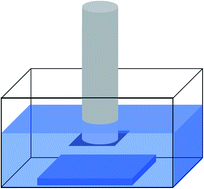Reversible adhesion between a hydrogel and a polymer brush
Abstract
We have developed a new experimental methodology to investigate the adhesive properties of hydrogels on solid surfaces under fully immersed conditions. The method, based on contact mechanics, provides time-resolved reproducible and quantitative data on the work of adhesion between a hydrogel at swelling equilibrium and a planar surface grafted with responsive brushes. We used poly(N,N-dimethylacrylamide) (PDMA) and polyacrylamide (PAM) as model gels and poly(acrylic acid) (PAA) as pH dependent polymer brush. The effect of pH, contact time and debonding velocity on adhesive interactions was specifically investigated. As expected from molecular interactions, we found that adhesion increased as the pH decreased and this was attributed to the formation of hydrogen bonds at the interface. Surprisingly, however, the buildup of adhesion increased slowly with the time of contact up to one hour and depended markedly on debonding velocity despite the very elastic nature of the hydrogels. Furthermore, the maximum pH where adhesion was observed was significantly higher for the couple PAM–PAA than for the couple PDMA–PAA, in contrast with the onset of molecular interactions in dilute solutions.

- This article is part of the themed collection: Mechanics and Physics of Hydrogels

 Please wait while we load your content...
Please wait while we load your content...